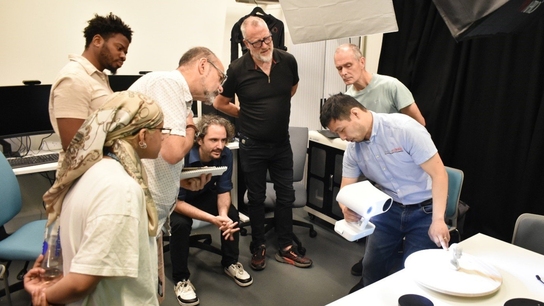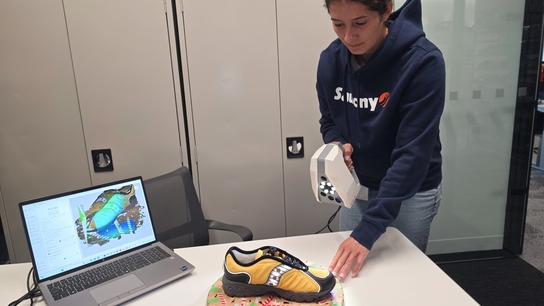Beyond the abyss: Artec Eva and Space Spider help explore Hoyo Negro
Challenge: The team of scientists needed a way to make highly precise 3D scans of the paleontological findings from Hoyo Negro – both bones and unique fauna species – for their groundbreaking Paleoamerican research.
Solution: Artec Space Spider, Artec Eva
Result: More than 200 fossils from Hoyo Negro scanned for use in a digital museum catalog, research, and potential VR simulation of the site.
Why Artec: Artec 3D scanners excel in scientific applications like Hoyo Negro exploration due to their high precision, portability, and fast scanning speed. Their ability to render delicate details while navigating challenging environments makes it entirely possible to quickly generate accurate 3D models ideal for documenting and studying plants, bones, geological formations, and other submerged cave features.

National Institute of Anthropology, Mexico. The robust tandem of Artec Eva and Space Spider at work. Image credit: Rapid Scan 3D
The mere contemplation of the underwater cave systems in the Yucatan Peninsula is captivating. Picture this: as rising sea levels flood the intricate network of underground passageways in the region, a deep pit within the colossal cave labyrinth known as Sac Actun becomes a natural trap. In this remarkable place called Hoyo Negro (Spanish for the “Black Hole”), the remains of amazing creatures like ground sloths, gomphotheres resembling elephants, tapirs, or saber-tooth cats are collected overtime.
Hoyo Negro: revealing secrets of the deep
The site has accumulated a mind-blowing collection of Late Pleistocene fossils, and become an exhilarating frontier for research – even more so upon discovering the skeleton of Naia, the most complete early human in the Americas. Featured as “a tiny 12,000-year-old teenager” on the cover of National Geographic, Naia fell into Hoyo Negro during the Ice Age when the area was still dry, only to resurface millennia later, revolutionizing the field of Paleoamerican studies.

Naia, the renowned Hoyo Negro finding that revolutionized Paleoamerican studies. Image credit: National Geographic
With a staggering number of well-preserved fossils submerged at depths exceeding 30 meters for the past 10,000 years, Hoyo Negro is a compelling site for exploration, though not without its logistical challenges. Accessing its world of Paleoamerican heritage became a reality thanks to a team effort from various leading research institutions, which coordinated expeditions to retrieve and study the underwater fossils.

The fossils found in these depths include those of elephants and saber-tooth cats. Image credit: Rapid Scan 3D
One stand-out collaboration is the joint project of East Tennessee State University (ETSU) and Instituto Nacional de Antropologia e Historia (INAH) in Mexico. As the project advanced, the necessity for digitizing the fossils became acute, emphasizing the importance of rendering them precisely yet safely. This is where next-gen technology took center stage, with the implementation of photogrammetry and 3D scanning techniques ensuring a meticulous and non-invasive approach to preserving and studying the fossils of Hoyo Negro.
Right people, right tools, right workflow
In the digitization phase of this research journey, a team comprising ETSU paleontologists Blaine Schubert and Chris Wedga, archeologist Jim Chatters, and Dominique Rissolo, developing the Hoyo Negro VR simulation at University of California, San Diego, alongside other experts and technicians, met in Mexico City with a mission to digitize the fossils obtained from the site.
For this task, the team opted for Artec Eva and Space Spider scanners, a choice influenced by their familiarity with Artec technology. The scanners were sourced from Rapid Scan 3D, an innovative Artec Ambassador that provides state-of-the-art 3D hardware and software, along with valuable expertise in the 3D scanning process. Rick Feijoo, a 3D solutions specialist from Rapid Scan, played a crucial role in the expedition, operating the scanners to capture precise digital representations of the fossils.

Rick Feijoo on the mission of digitizing underwater fossils – rapidly and safely. Image credit: Rapid Scan 3D
Over four days, each filled with about 8 hours of dedicated scanning at the National Institute of Anthropology, the team scanned over 200 fossils, including such findings as the remains of Giant Tree Sloths and a fragment of a mammoth hip. Adding a dash of excitement, most of the scanned Giant Tree Sloth fossils turned out to be a new species! With fossils being so diverse in sizes and shapes, it was helpful to have a pair of Artec scanners at hand. While the Space Spider, renowned for its precision in capturing intricate details, was deployed for smaller objects and more complex geometry, Eva took the lead for medium-sized textured items.
Rick Feijoo noted that scanning with Artec proved to be a breeze, with the entire process of scanning and data processing taking a mere 5 to 15 minutes. This efficiency not only facilitated the workflow but also highlighted the remarkable speed of Artec scanners in transforming fragile fossils into accurate digital replicas.
From fossils to future: 3D tech shaping the next stage of paleontological exploration
In the future of Hoyo Negro research, the role of the right technology emerges as a great force. Given the challenges posed by underwater conditions, scientists and divers initially resorted to photogrammetry and photography, lugging heavy equipment such as high-powered lights and cameras beneath the water’s surface. However, the seamless integration of Artec 3D scanners, a technology the entire group was already familiar with, proved to be a true game-changer. With the inclusion of Eva and Space Spider in the workflow, the precision and speed of digitizing fossils skyrocketed, resulting in 3D data that is high-res and lifelike as never before. These scans now have all the chances to shape the course of future studies, as well as be instrumental in several projects at once.

Processing the scans in Artec Studio. Image credit: Rapid Scan 3D
One initiative is cataloging the bones for building a substantial repository of fossils at ETSU, which stands out as one of the leading institutions in the study of the giant tree sloth. The university’s Gray Fossil Site & Museum is at the forefront of advanced paleontological research, and with its ambitious vision, the goal is to construct a comprehensive digital collection that not only serves as a rare resource for researchers, but also fosters engaging learning and knowledge sharing about the fascinating creatures, making the museum a key hub for education, exploration, and discovery.
Another thrilling perspective is using the scans for the virtual reality simulation of Hoyo Negro developed at University of California, San Diego. This immersive project recreates the submerged archaeological site as an interactive 3D environment, allowing exploration in astonishing detail from anywhere, whether on a laptop or in a walk-in virtual reality facility.

Where saber-tooth cats once roamed! Image credit: Rapid Scan 3D
While Naia, the renowned Hoyo Negro finding, has contributed to our understanding of the ancestry, growth, and development of early Americans, questions persist. Why did she and her contemporaries venture into the labyrinth of caves beneath the Yucatan Peninsula’s surface? What did their world look like? What Ice Age creatures roamed the region before meeting their fate in the Hoyo Negro abyss?
It’s astounding to think how a high-quality 3D scan can assist scientists, engineers, 3D-modeling experts, and VR specialists in safely bringing these fragments of Ice Age back to light. The journey into the depths of Hoyo Negro, once unimaginable, continues to unfold.
Scanners behind the story
Try out the world's leading handheld 3D scanners.






